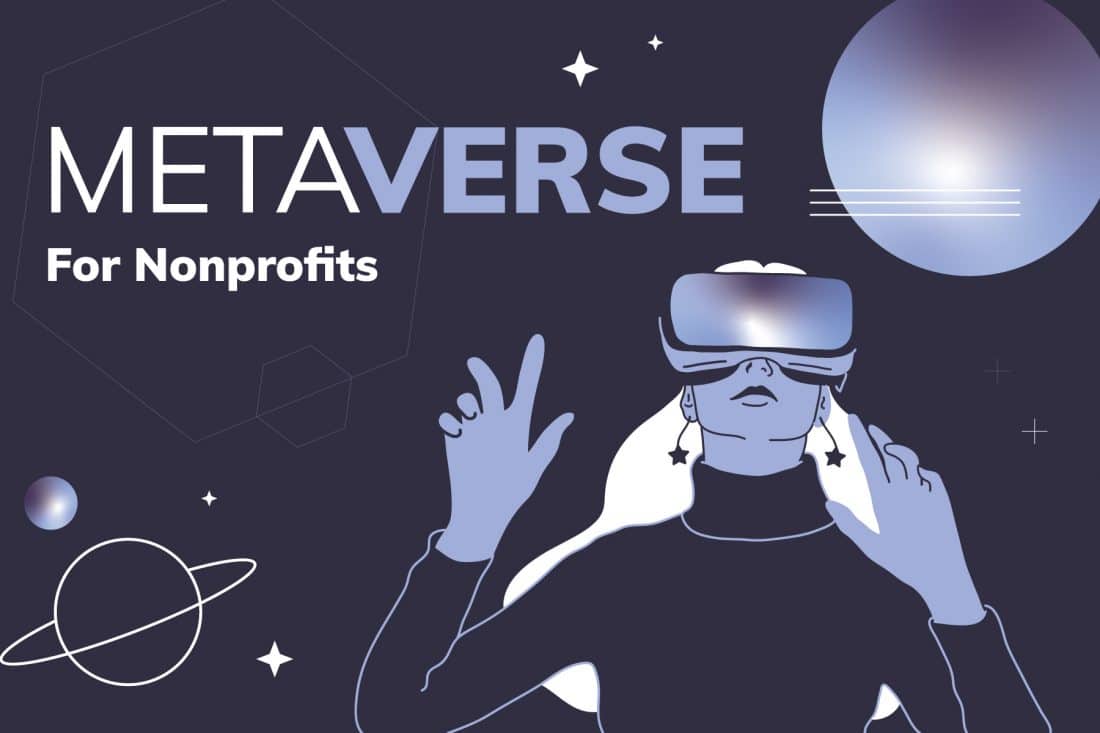
Metaverse 101 for Nonprofits
Metaverse is a word that carries a lot of weight these days, and it seems like the loudest voices on the topic are on opposite ends of the spectrum. The concept can feel convoluted, leaving many asking, “What even is the metaverse? What does it have to do with me?”
As a nonprofit organization, these questions are becoming more relevant as many nonprofits are feeling the push of the metaverse in the form of crypto-donations, NFT fundraisers, environmental concerns, and cyber advocacy. This is the first post in our series on the metaverse, where we’ll uncover what nonprofits need to know about entering the metaverse. To begin, we’re breaking down the very basic foundation and structure of the current “metascape” from a nonprofit perspective and sharing questions your organization should ask before staking your own claim in the metaverse.
What is the Metaverse?
Ask anyone to define the metaverse, and you’ll get a myriad of responses, primarily because the metaverse is both conceptual and tangible in where it stands today. In essence, the metaverse is a virtual reality layered on top of our physical reality—a place where anything and everything that can happen physically can happen digitally. There won’t be a clear “before and after” the metaverse because it is so multi-faceted, but we can see expressions of a future metaverse already happening now. So what, in the most basic sense, is the metaverse currently composed of?
Cryptocurrency
Cryptocurrency, or “crypto,” is a decentralized, digital currency formed on blockchain technology. Most people have heard of Bitcoin (BTC), which was the first version of crypto, but many more have emerged since, such as Ethereum (ETH) and Litecoin (LTC). Crypto was formed to create a decentralized, universal form of currency that could be traded and logged on a transparent proof system rather than controlled by governments.
NFTs
According to Forbes, a non-fungible token, or “NFT,” is “a digital asset that represents real-world assets like art, music, in-game items and videos.” NFTs are typically encoded on a blockchain the same way that crypto is. NFTs have been seen as an investment opportunity for many and, in the nonprofit world, a new way to fundraise.
Virtual Reality (VR)
Virtual reality is a “near-reality” experience that allows the user to process sensory information through a computer-generated virtual environment. Virtual reality experiences include immersive films, video games, simulations for job training (such as pilots and surgeons), and more.
Augmented Reality (AR)
Augmented reality is a 3D technology that allows the user to see the real-world environment with a digital augmentation overlay. This includes technology such as filters (popular on social media platforms like Snapchat, TikTok, and Instagram), games (ex: Pokemon Go), and retail shopping (ex: virtual try-on items).
Stepping into the Metaverse
So what should your nonprofit be doing in or about the metaverse? We can’t tell you what to do, but we do think that each organization should make informed decisions about how involved they should be. Here are three questions to springboard conversations about the metaverse in your organization:
1. What do your stakeholders think about it?
Your board, donors, staff, volunteers, and community are all important voices to consider when deciding your next step into the metaverse. Get a pulse check from your people.
2. Does it align with your mission?
Whether accepting crypto donations, creating an NFT auction, or purchasing advertising in the metaverse, keep your mission in mind. If something is unaligned, consider alternatives or not participating. (Here’s an example of what can happen when action and mission are misaligned).
3. What are the risks for your organization, and can it withstand them?
There is a big difference between hosting a crypto fundraising campaign for #CryptoGivingTuesday and building an immersive world in VR. Keep a budget and long-term goals in mind when assessing risk and return on your investment in the metaverse.
Whether your organization is ready and equipped to take the lead in the metaverse, or your sentiment about it is to steer clear, remember to remain informed as technology advances, and don’t let the fear of missing out take the lead. And stay tuned for the next blog in our series on uncovering the metaverse for nonprofits.
Looking for more resources? Check out some of our favorites below and read part two of our metaverse series here.
-
- WIRED – What Is The Metaverse, Exactly?
- Forbes – What Is The Metaverse And Why Should You Care?
- Vice – What Is The Metaverse? An Explanation For People Who Don’t Get It.
- Forbes – What Is Cryptocurrency?
- The Giving Block – Crypto Glossary For Nonprofits And Donors: 35+ Terms Explained
- The Giving Block – What Is Cryptocurrency?
- Classy – NFT Fundraising Explained: What Is A Non-Fungible Token Donation?
- Forbes – What is an NFT? Non-Fungible Tokens Explained
- Investopedia – Non-Fungible Token (NFT)
- VRS – What Is Virtual Reality?
- Oculus – What Is Virtual Reality All About?
- Wondershare – What Is Virtual Reality And How Does It Work?
- Investopedia – Augmented Reality
- Business Insider – What Is Augmented Reality? Here’s What You Need To Know About The 3D Technology.
- SAP – What Is Augmented Reality?